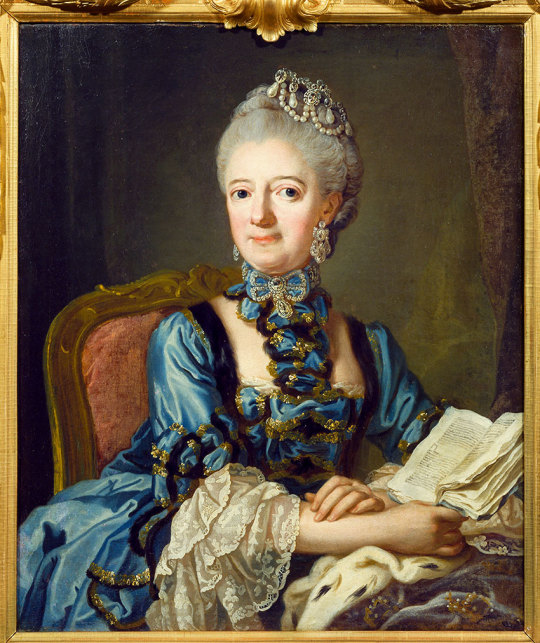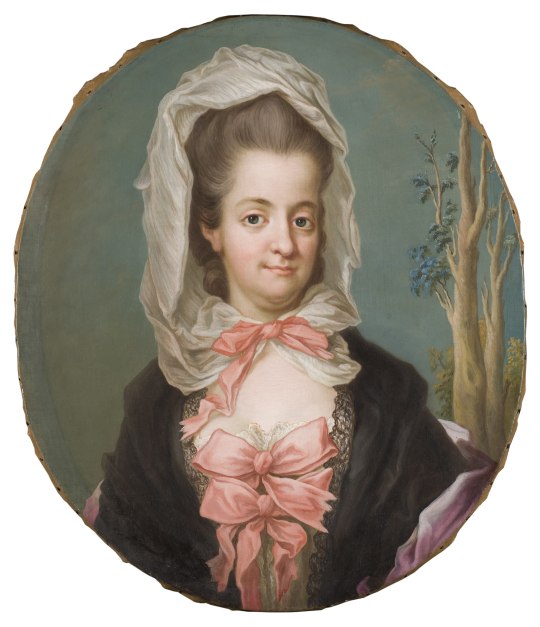#princess louisa ulrika of prussia
Explore tagged Tumblr posts
Text

Queen Lovisa Ulrika of Sweden by Lorens Pasch the Younger (oil on canvas, 1768)
The talented, highly educated Lovisa Ulrika became one of Sweden's leading cultural figures. No other Swedish queen has left more of a mark on the theatre, and she also breathed new life into royal entertainment. She built up the palace theatres at Drottningholm and Ulriksdal.
Lovisa Ulrika was influenced by the ideals of the French Enlightenment. As a queen, she used the resources at her disposal to promote culture and science. For example, she supported the Swedish writer Hedvig Charlotta Nordenflycht and was also a patron of Carl Linnaeus.
In 1753, Lovisa Ulrika established the Royal Swedish Academy of Letters, a centre of knowledge for research within the humanities.
Photo: royalpalaces.se
#swedish royal family#official portrait#queen lovisa ulrika#luise ulrike von preußen#louisa ulrika of prussia#prinzessin luise ulrike von preußen#princess louisa ulrika of prussia#house of hohenzollern#art history#swedish royalty#swedish history#royal history#my upload
40 notes
·
View notes
Photo










House of Hohenzollern: Princess Anna Amalia (Amalie) of Prussia
Anna Amalia was born as the youngest daughter and third youngest child of King Frederick William I. of Prussia and his wife Princess Sophia Dorothea of Hanover. She is the younger sister of Frederick the Great, Queen Louisa Ulrika of Sweden, Duchess Philippine Charlotte of Brunswick-Wolfenbüttel, Margravine Frederica Louise of Brandenburg-Ansbach, Margravine Sophie Dorothea of Brandenburg-Schwedt and Margravine Wilhelmine of Brandenburg-Bayreuth. She was nicknamed Amélie.
Amalia was like her older brother and sister Wilhelmine a great lover of music. But for her it was only possible to receive a formal education in it after her art hating father had died. This however did not stop her from becoming a patron and composer herself in later life. Her first teacher however had been Frederick himself who was encouraged by their mother Sophia Dorothea to do so. Anna Amalia became later a confidant of her brother. Contemporaries contribute this to their similar personalities.
Frederick, now king, also suggested Anna Amalia instead of their other sister Louisa Ulrika as a bride for the then Crown Prince of Sweden. In his opinion Louisa was too ambitious and independent for a monarchy without real power and because of that also probably harder to influence to act in Prussia’s interest. Amalia, on the other hand, he described as mild and kind. The Swedish however chose Louise Ulrika as bride and married Crown Prince Adolf Frederick in 1744.
At this wedding, Amalia supposedly met Baron Friedrich von der Trenck for the first time. They allegedly had an affair but none of that is currently to be true. The rumor started because of von der Trenck’s bragging in his memoires. However, there is one letter from 1787 which at least hints they shared a very close relationship. However, von der Trenck was arrested in 1745, probably because Frederick the Great suspected him to spy for his Austrian cousin Baron Franz von der Trenck. After Trenck’s arrestment, it is reported by contemporaries that Anna Amalia became more and more sarcastic, mean, self-opinionated and unbalanced in general.
At the age of 32 or 33, Anna Amalie was still unmarried. To take care of her, her brother made her Princess-Abbess of Quedlinburg in 1756. Although this position made her a rich woman, she rarely visited Quedlinburg and spent most of her life in Berlin. Especially during the Seven Years War, she attended the royal court which was managed by her sister-in-law Elisabeth Christine of Brunswick-Wolfenbüttel-Bevern, Frederick the Great’s wife and Prussian queen.
Anna Amalia’s health declined with age and she even became blind. Frederick the Great’s youngest sister died on March 30th, 1787, and is buried in the Hohenzollerngruft at Berlin Cathedral. Her collection of music and library in general were split between East and West Germany after the Second World War but were reunited in 1990 and now reside in the Berlin State Library.
// Alexandra Maria Lara as Princess Amélie in Trenck - Zwei Herzen gegen die Krone (2003)
#historyedit#period drama#perioddramaedit#women in history#1700s#18th century#Princess Anna Amalia of Prussia#German history#European history#Trenck - Zwei Herzen gegen die Krone#Royal Women of Prussia#house of hohenzollern#sisters of Frederick the Great#unmarried women
169 notes
·
View notes
Photo










Royal Birthdays for today, July 24th:
Catherine of Saxony, Archduchess of Austria, 1468
Maria of the Palatinate, Duchess of Södermanland, 1561
Prince William, Duke of Gloucester, 1689
Louisa Ulrika of Prussia, Queen of Sweden, 1720
Victor Emmanuel I, Kind of Sardinia, 1759
Adolphe, Grand Duke of Luxembourg, 1817
Louis-Philippe, Crown Prince of Belgium, 1833
Charlotte of Prussia, Duchess of Saxe-Meiningen, 1860
Sarvath El Hassan, Princess of Jordan, 1947
Diana of Orleans, Duchess of Anjou, 1978
#catherine of saxony#maria of the palatinate#prince william#Louisa Ulrika of Prussia#victor emmanuel i#Charlotte of Prussia#grand duke Adolphe#prince Louis-Philippe#Sarvath El Hassan#Diana of Orleans#long live the queue#royal birthdays
50 notes
·
View notes
Photo

Princess Sofia Albertina of Sweden and Norway. Attributed to Jakob Björck.
Sophia Albertina was the daughter of King Adolf Frederick of Sweden and Louisa Ulrika of Prussia. She was thus a princess of Sweden, a princess of Holstein-Gottorp and a sister to Gustav III of Sweden. She was a member of the Accademia di San Luca. When her brother Charles XIII of Sweden and the rest of the royal family also became Norwegian royalty in 1814, that did not include Sophia Albertina who then officially was called Royal Princess (of no country).
#Jakob Björck#Gustaf Lundberg#konungariket sverige#prinsessa av sverige#princess abbess#kingdom of sweden#house of holstein gottorp
0 notes
Photo

Princess Louisa Ulrika of Prussia, by Antoine Pesne
28 notes
·
View notes
Photo










House of Hanover & of Hohenzollern: Princess Sophia Dorothea of Hanover, Princess of Great Britain
Sophia Dorothea was the second child and only daughter of King George I of Great Britain, The Elector of Hanover, and his wife Princess Sophia Dorothea of Brunswick-Lüneburg-Celle, better known as Sophia of Celle or The Princess of Ahlden.
After the imprisonment of her mother, Sophia and her brother were raised in Hanover by their grandmother Princess Sophie (Sophia) of the Palatine, The Electress of Hanover, through who the House of Hanover would also ultimately claim the British throne. Until he was three years old, Sophia Dorothea’s future husband Electoral-Prince Frederick William of Prussia was raised by their common grandmother as well. However, Frederick did not care for Sophia as a child and even bullied her brother, the future King of Britain.
Nevertheless, Sophia Dorothea and Frederick William were wed on November 28th, 1706. The couple could not have been different. While he would become known as The Soldier King, she was a person who was interest in the fine arts which her children, to their father’s displeasure, would mostly inherit from her. Sophia Dorothea also corresponded with Princess Palatine Elisabeth Charlotte “Liselotte”, The Duchess of Orléans who was a cousin of her mother’s and had also been raised once by Electress Sophia.
Frederick William and Sophia Dorothea would go on to have 14 children. Among them Frederick the Great, Princess Wilhelmine, Princess Anna Amalia and Princess Louisa Ulrika, who would become Queen of Sweden. Sophia Dorothea had always wanted to marry one of her children to one of her British relatives. However, although she tried it multiple times, a Prussian-Anglo alliance was never made in that generation. Instead most of her children married within the kingdom of Prussia or into the House of Welf she herself descended from.
Sophia was close to her eldest son all life long. She knew about his escape plans and together with her daughter Wilhelmine destroyed as much evidence as they could after the escape failed. Frederick showed his appreciation of his mother by keeping her the first lady of Prussia even after his father’s death. Sophia Dorothea outranked her daughter-in-law Princess Elisabeth Christine of Brunswick-Wolfenbüttel-Bevern. Additionally, Frederick demanded that she would be referred to as Queen Mother and not as Queen Dowager as it should have been by tradition. Furthermore, he asked his mother not to adress him as Majesty but as her son as this was to him the highest honor he could ever receive by her.
Sophia Dorothea died on June 28th, 1757, after her health had been declining. Her final resting place in the Hohenzollern vault in Berlin Cathedral. She was the last Queen in Prussia, since her son and by that his wife became monarch of Prussia in 1772.
// Christina Große as Sophia Dorothea in Friedrich - Ein deutscher König (2011)
#historical women#historyedit#period drama#perioddramaedit#German History#House of Hanover#European history#House of Hohenzollern#House of Welf#Sophia Dorothea of Hanover#Royal Women of Prussia#Women of the House of Hanover#queens in prussia#Princess of Great Britain
215 notes
·
View notes
Photo










Royal Birthdays for today, July 24th:
Catherine of Saxony, Archduchess of Austria, 1468
Maria of the Palatinate, Duchess of Södermanland, 1561
Prince William, Duke of Gloucester, 1689
Louisa Ulrika of Prussia, Queen of Sweden, 1720
Victor Emmanuel I, Kind of Sardinia, 1759
Adolphe, Grand Duke of Luxembourg, 1817
Louis-Philippe, Crown Prince of Belgium, 1833
Charlotte of Prussia, Duchess of Saxe-Meiningen, 1860
Sarvath El Hassan, Princess of Jordan, 1947
Diana of Orleans, Duchess of Anjou, 1978
#catherine of saxony#Maria of the Palatinate#prince william#Louisa Ulrika of Prussia#Victor Emmanuel I#grand duke adolphe#prince louis-philippe#Charlotte of Prussia#Sarvath El Hassan#diana of orleans#royal birthdays#long live the queue
47 notes
·
View notes